16.9: Applying the Nursing Process
- Page ID
- 52513
\( \newcommand{\vecs}[1]{\overset { \scriptstyle \rightharpoonup} {\mathbf{#1}} } \)
\( \newcommand{\vecd}[1]{\overset{-\!-\!\rightharpoonup}{\vphantom{a}\smash {#1}}} \)
\( \newcommand{\dsum}{\displaystyle\sum\limits} \)
\( \newcommand{\dint}{\displaystyle\int\limits} \)
\( \newcommand{\dlim}{\displaystyle\lim\limits} \)
\( \newcommand{\id}{\mathrm{id}}\) \( \newcommand{\Span}{\mathrm{span}}\)
( \newcommand{\kernel}{\mathrm{null}\,}\) \( \newcommand{\range}{\mathrm{range}\,}\)
\( \newcommand{\RealPart}{\mathrm{Re}}\) \( \newcommand{\ImaginaryPart}{\mathrm{Im}}\)
\( \newcommand{\Argument}{\mathrm{Arg}}\) \( \newcommand{\norm}[1]{\| #1 \|}\)
\( \newcommand{\inner}[2]{\langle #1, #2 \rangle}\)
\( \newcommand{\Span}{\mathrm{span}}\)
\( \newcommand{\id}{\mathrm{id}}\)
\( \newcommand{\Span}{\mathrm{span}}\)
\( \newcommand{\kernel}{\mathrm{null}\,}\)
\( \newcommand{\range}{\mathrm{range}\,}\)
\( \newcommand{\RealPart}{\mathrm{Re}}\)
\( \newcommand{\ImaginaryPart}{\mathrm{Im}}\)
\( \newcommand{\Argument}{\mathrm{Arg}}\)
\( \newcommand{\norm}[1]{\| #1 \|}\)
\( \newcommand{\inner}[2]{\langle #1, #2 \rangle}\)
\( \newcommand{\Span}{\mathrm{span}}\) \( \newcommand{\AA}{\unicode[.8,0]{x212B}}\)
\( \newcommand{\vectorA}[1]{\vec{#1}} % arrow\)
\( \newcommand{\vectorAt}[1]{\vec{\text{#1}}} % arrow\)
\( \newcommand{\vectorB}[1]{\overset { \scriptstyle \rightharpoonup} {\mathbf{#1}} } \)
\( \newcommand{\vectorC}[1]{\textbf{#1}} \)
\( \newcommand{\vectorD}[1]{\overrightarrow{#1}} \)
\( \newcommand{\vectorDt}[1]{\overrightarrow{\text{#1}}} \)
\( \newcommand{\vectE}[1]{\overset{-\!-\!\rightharpoonup}{\vphantom{a}\smash{\mathbf {#1}}}} \)
\( \newcommand{\vecs}[1]{\overset { \scriptstyle \rightharpoonup} {\mathbf{#1}} } \)
\(\newcommand{\longvect}{\overrightarrow}\)
\( \newcommand{\vecd}[1]{\overset{-\!-\!\rightharpoonup}{\vphantom{a}\smash {#1}}} \)
\(\newcommand{\avec}{\mathbf a}\) \(\newcommand{\bvec}{\mathbf b}\) \(\newcommand{\cvec}{\mathbf c}\) \(\newcommand{\dvec}{\mathbf d}\) \(\newcommand{\dtil}{\widetilde{\mathbf d}}\) \(\newcommand{\evec}{\mathbf e}\) \(\newcommand{\fvec}{\mathbf f}\) \(\newcommand{\nvec}{\mathbf n}\) \(\newcommand{\pvec}{\mathbf p}\) \(\newcommand{\qvec}{\mathbf q}\) \(\newcommand{\svec}{\mathbf s}\) \(\newcommand{\tvec}{\mathbf t}\) \(\newcommand{\uvec}{\mathbf u}\) \(\newcommand{\vvec}{\mathbf v}\) \(\newcommand{\wvec}{\mathbf w}\) \(\newcommand{\xvec}{\mathbf x}\) \(\newcommand{\yvec}{\mathbf y}\) \(\newcommand{\zvec}{\mathbf z}\) \(\newcommand{\rvec}{\mathbf r}\) \(\newcommand{\mvec}{\mathbf m}\) \(\newcommand{\zerovec}{\mathbf 0}\) \(\newcommand{\onevec}{\mathbf 1}\) \(\newcommand{\real}{\mathbb R}\) \(\newcommand{\twovec}[2]{\left[\begin{array}{r}#1 \\ #2 \end{array}\right]}\) \(\newcommand{\ctwovec}[2]{\left[\begin{array}{c}#1 \\ #2 \end{array}\right]}\) \(\newcommand{\threevec}[3]{\left[\begin{array}{r}#1 \\ #2 \\ #3 \end{array}\right]}\) \(\newcommand{\cthreevec}[3]{\left[\begin{array}{c}#1 \\ #2 \\ #3 \end{array}\right]}\) \(\newcommand{\fourvec}[4]{\left[\begin{array}{r}#1 \\ #2 \\ #3 \\ #4 \end{array}\right]}\) \(\newcommand{\cfourvec}[4]{\left[\begin{array}{c}#1 \\ #2 \\ #3 \\ #4 \end{array}\right]}\) \(\newcommand{\fivevec}[5]{\left[\begin{array}{r}#1 \\ #2 \\ #3 \\ #4 \\ #5 \\ \end{array}\right]}\) \(\newcommand{\cfivevec}[5]{\left[\begin{array}{c}#1 \\ #2 \\ #3 \\ #4 \\ #5 \\ \end{array}\right]}\) \(\newcommand{\mattwo}[4]{\left[\begin{array}{rr}#1 \amp #2 \\ #3 \amp #4 \\ \end{array}\right]}\) \(\newcommand{\laspan}[1]{\text{Span}\{#1\}}\) \(\newcommand{\bcal}{\cal B}\) \(\newcommand{\ccal}{\cal C}\) \(\newcommand{\scal}{\cal S}\) \(\newcommand{\wcal}{\cal W}\) \(\newcommand{\ecal}{\cal E}\) \(\newcommand{\coords}[2]{\left\{#1\right\}_{#2}}\) \(\newcommand{\gray}[1]{\color{gray}{#1}}\) \(\newcommand{\lgray}[1]{\color{lightgray}{#1}}\) \(\newcommand{\rank}{\operatorname{rank}}\) \(\newcommand{\row}{\text{Row}}\) \(\newcommand{\col}{\text{Col}}\) \(\renewcommand{\row}{\text{Row}}\) \(\newcommand{\nul}{\text{Nul}}\) \(\newcommand{\var}{\text{Var}}\) \(\newcommand{\corr}{\text{corr}}\) \(\newcommand{\len}[1]{\left|#1\right|}\) \(\newcommand{\bbar}{\overline{\bvec}}\) \(\newcommand{\bhat}{\widehat{\bvec}}\) \(\newcommand{\bperp}{\bvec^\perp}\) \(\newcommand{\xhat}{\widehat{\xvec}}\) \(\newcommand{\vhat}{\widehat{\vvec}}\) \(\newcommand{\uhat}{\widehat{\uvec}}\) \(\newcommand{\what}{\widehat{\wvec}}\) \(\newcommand{\Sighat}{\widehat{\Sigma}}\) \(\newcommand{\lt}{<}\) \(\newcommand{\gt}{>}\) \(\newcommand{\amp}{&}\) \(\definecolor{fillinmathshade}{gray}{0.9}\)Now that we have discussed several alterations in elimination, let’s apply the nursing process to patients experiencing these conditions.
Assessment
Urinary Elimination Assessment
Assessment of the urinary system includes asking questions about voiding habits, frequency, and if there is difficult or painful urination. The bladder may be palpated above the symphysis pubis for distention. If the patient has incontinence, the perineal area should be inspected for skin breakdown. If urinary retention is suspected, a post-void residual amount may be measured by using a bladder scanner or by straight urinary catheterization. For a summary of common signs and symptoms associated with alterations in urinary elimination, see the “Selected Defining Characteristics” listed in Table 16.9a under the “Diagnosis” subsection.
If a patient has had an indwelling urinary catheter removed recently, specific assessments should be performed to monitor for urinary tract infection and other complications. Read more about caring for patients with urinary catheters in the “Facilitation of Elimination” chapter in Open RN Nursing Skills.
Bowel Elimination Assessment
Subjective assessment of the bowel system includes asking about the patient’s normal bowel pattern, the date of the last bowel movement, characteristics of the stool, and if any changes have occurred recently in stool characteristics or pattern. A normal pattern is typically one bowel movement every one to three days with stools having a soft or formed consistency. Refer to Figure 16.6[1] under the “Constipation” section regarding using the Bristol Stool Chart to evaluate stool consistency.
Based on the patient’s answers, additional questions can be included, such as bowel routines/toileting, the amount of fiber and fluid in the daily diet, daily activity, and the use of opioid medications. Keep in mind that patients who have recently undergone diagnostic procedures that include barium contrast can have significant hardening of the stool if the barium is not expelled within a day or two of the procedure. Patients are typically prescribed a stimulant laxative (such as Milk of Magnesia) to promote barium expulsion after these types of procedures. Additionally, patients who have recently had abdominal surgical procedures under general anesthesia are at increased risk of paralytic ileus.
For a summary of common symptoms associated with alterations in urinary elimination, see the “Selected Defining Characteristics” listed in Table 16.9a under the “Diagnosis” subsection.
The abdomen should be auscultated for bowel sounds, noting if they are present, hyperactive, or hypoactive in all four quadrants. If bowel sounds are absent or there are other signs of possible obstruction or paralytic ileus, the provider should be notified immediately. A light palpitation of the abdomen is performed to determine if there are tender areas, abnormal masses, or a firmness in the left lower quadrant indicating the presence of stool.
During inpatient care, the patient is often requested to call the nurse when a bowel movement has occurred so the stool characteristics can be assessed. Document the amount (small, medium, or large), consistency (soft, formed, or hard) and color (brown or other color). Alterations in these characteristics can be caused by several conditions, such as infection, parasites, inflammatory conditions of the intestines, or gallbladder or liver conditions.
Some patients have surgical diversions for diseases such as diverticulitis or cancer. Ostomies are surgical openings in the abdomen for the expulsion of stool into a bag-like appliance. An ileostomy is an opening created at the juncture of the small and large intestines, so the stool has a liquid consistency. A colostomy is placed farther along the large intestines, where more water has been absorbed, so the stool is more formed.
Read about expected and unexpected findings during an abdominal assessment in the “Abdominal Assessment” chapter in Open RN Nursing Skills.
Read about caring for patients with ostomies in the “Facilitation of Elimination” chapter in Open RN Nursing Skills.
Urinary Diagnostic Tests
There are several commonly ordered diagnostic tests for urinary conditions, such as a urine dip, urinalysis, urine culture, cystoscopy, and urodynamic flow studies.
Urine Dip
A urine dip test refers to a treated chemical strip (dipstick) being placed in a urine sample. Patches on the dipstick will change color to indicate the presence of substances such as white blood cells, protein, or glucose. See Figure 16.7[2] for an image of a urine dipstick test. Urine is collected for a urine dip test in a clean container. Using the “clean catch” technique, the skin surrounding the urethra should be cleaned with a special towelette before the urine is collected. Catching the urine “midstream” is the goal, so request the patient to start urinating, stop, and then urinate into the container.

Urinalysis
A urinalysis includes a physical, chemical, and microscopic examination of urine by a lab technician. It requires collection of a “clean catch” urine sample in a sterile container. It involves checking the urine with a microscope for the following:
- Color
- Appearance (i.e., clear or cloudy)
- Odor
- pH level (acidity)
- Substances not usually found in significant amounts in the urine, such as red blood cells, white blood cells, leukocyte esterase, bacteria, protein, glucose, ketones, and bilirubin
- Cells, crystals, and casts[3]
See Figure 16.8[4] for an image of white blood cells, referred to as pyuria, as seen on a urinalysis under a microscope. A urinalysis looks for evidence of infection, including elevated numbers of bacteria and white blood cells. A positive leukocyte esterase test or the presence of nitrite also supports the diagnosis of a UTI.[5]
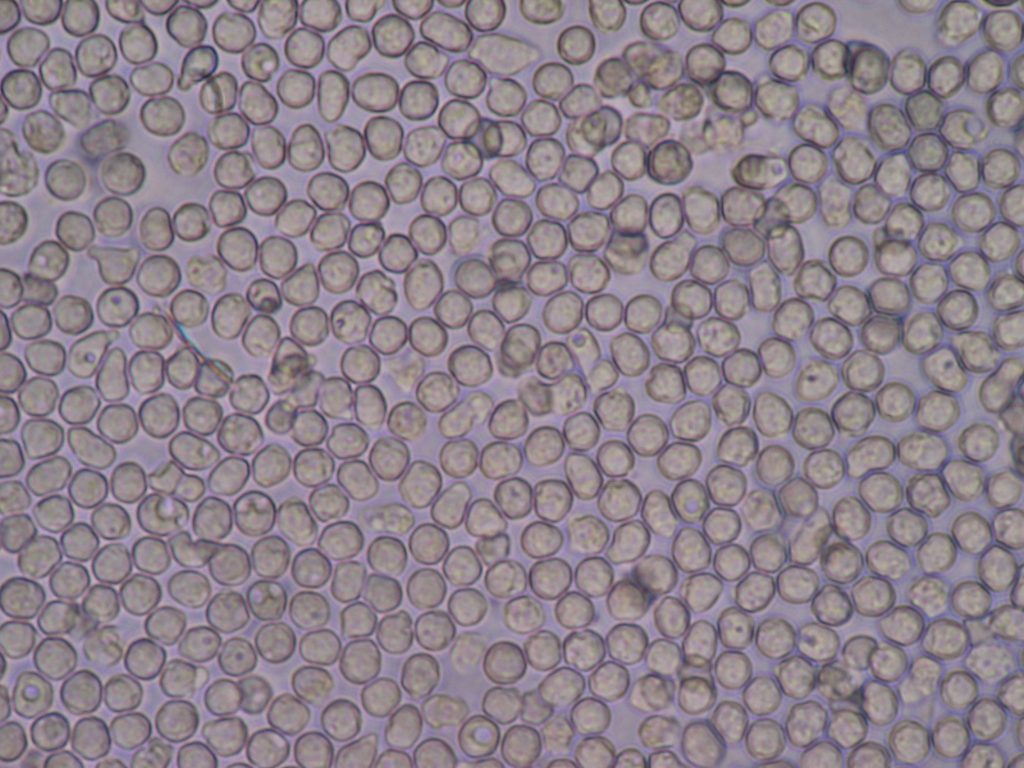
Urine Culture
A urine culture identifies the specific microbe causing a urinary tract infection. If this is the patient’s first, uncomplicated UTI of the lower urinary tract, the provider often assumes it is caused by the most common microbe, E. coli, and treats it with antibiotics without performing a culture. However, cultures are typically performed for patients with recurring UTIs or hospitalized patients at risk for hospital-associated infections.[6]
When interpreting urine culture results, the presence of a single type of bacteria growing at high colony counts is typically considered a positive urine culture. For clean catch samples that have been properly collected, cultures with greater than 100,000 colony forming units (CFU)/milliliter of one type of bacteria usually indicate infection.[7]
If a culture is positive, susceptibility testing is performed to guide treatment. Although a variety of bacteria can cause UTIs, most are due to Escherichia coli (E. coli) bacteria that are common in the digestive tract and routinely found in stool. Other bacteria that commonly cause UTIs include Proteus, Klebsiella, Enterobacter, Staphylococcus, and Acinetobacter. Susceptibility testing determines which antibiotics will inhibit the growth of the specific bacteria causing the infection. It is important for nurses to review culture results to verify the antibiotic therapy being administered has been found to be effective against the type of bacteria discovered in the culture. If there is any concern about the susceptibility results and current antibiotic therapy, the health care provider should be notified.
A culture that is reported as “no growth in 24 or 48 hours” usually indicates that there is no infection. If a culture shows growth of several different types of bacteria, then it is likely due to contamination of the urine sample during collection. This is especially true in voided urine samples if the organisms present include Lactobacillus and/or other common nonpathogenic vaginal bacteria in women. The provider may request a repeat culture on a sample that is more carefully collected.[8]
Cystoscopy
A cystoscopy is a procedure completed by a health care provider with a cystoscope, a small, thin tube with a camera on the end that is inserted into the urethra and into the bladder. See Figure 16.9[9] for an illustration of cystoscopy. Fluid is inserted to expand the bladder so the bladder walls can be visualized. Biopsy samples can be taken from abnormal tissue through the tube and then sent to a medical lab for analysis. The patient will feel the need to urinate when the bladder is full, but the bladder must stay full until the procedure is completed. A slight pinch may be felt if a biopsy sample is obtained. After the procedure, the patient should be encouraged to drink 4 to 6 glasses of water per day, as appropriate for their medical status. A small amount of blood may be present in the urine after the procedure, but if the bleeding continues after urinating three times, or if other signs of infection are present, the provider should be notified.[10]
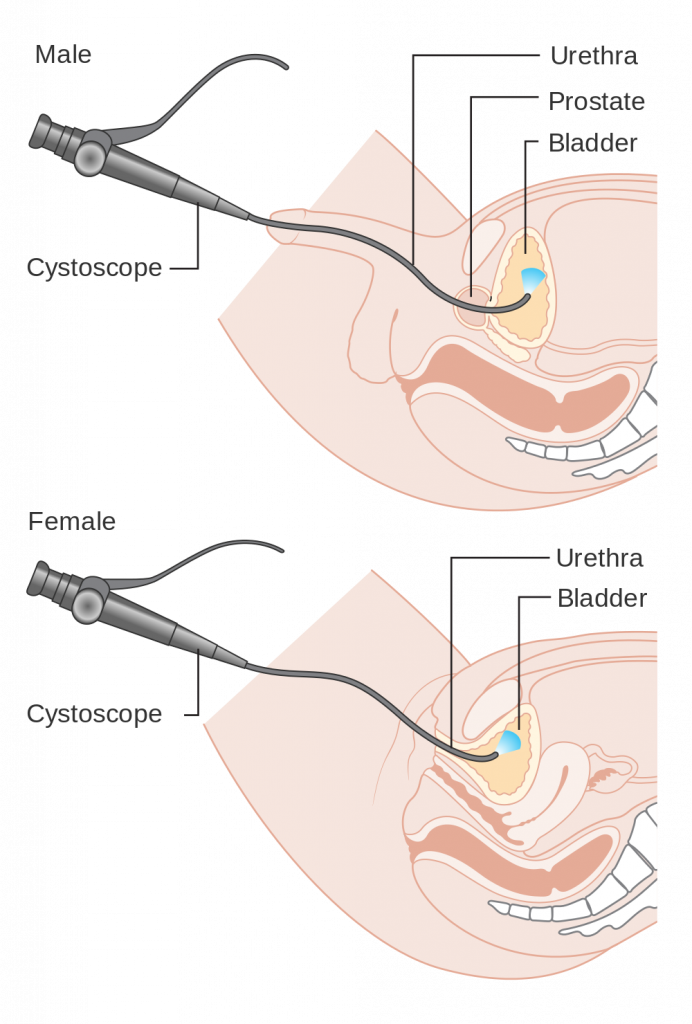
Urodynamic Flow Test
Urodynamic testing is any procedure that looks at how well the bladder, sphincters, and urethra are storing and releasing urine. Most urodynamic tests focus on the bladder’s ability to hold urine and empty steadily and completely. Urodynamic tests can also show whether the bladder is having involuntary contractions that cause urine leakage.[11]
Bowel Diagnostic Tests
There are several common diagnostic tests related to bowel elimination, including stool-based tests, a colonoscopy, a barium enema, and an abdominal CT scan.
Stool-Based Tests
Stool samples can be tested for cancer, parasites, or for occult blood (i.e., hidden blood). Follow specific instructions from the lab for collecting the sample.
The Guaiac-Based Fecal Occult Blood Test finds hidden blood in the stool. As a screening test for colon cancer, it is performed annually. Before the test, the patient should avoid many foods, such as red meat, melons, beets, and grapefruit for three days. They should not take aspirin or NSAIDs for seven days prior to the test. Stool samples from three separate bowel movements are smeared onto small paper cards and then returned to the medical lab for testing. If the test is positive (i.e., hidden blood is found), a follow-up colonoscopy is scheduled.[12] See Figure 16.10[13] for an image of a typical card used to collect the stool smear for the test after a special solution has been applied. The blue color indicates a positive result for occult blood.
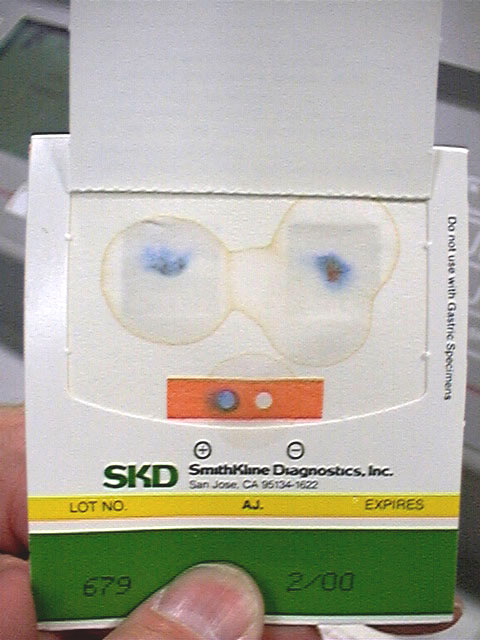
The Stool DNA Test (also called Cologuard) looks for certain abnormal sections of DNA from cancer or polyp cells and also checks for occult blood. Specific collection kits, including a sample container, liquid preservative, and specific instructions are provided.[14]
Colonoscopy
During a colonoscopy, an instrument called a colonoscope is used. The colonoscope has a tiny camera attached to a long, thin tube that is inserted into the anus to check the entire colon and rectum. See Figure 16.11[15] for an illustration of a colonoscopy. This procedure is used to screen patients for colon cancer. Screening is recommended to start at age 50 (or 45 for high-risk populations, including African Americans), and thereafter once every ten years or as prescribed by the provider. It is also used to evaluate the colon for inflamed tissue and abnormal growths or lesions. Before the procedure, the patient must complete a bowel prep that typically consists of a clear liquid diet and laxatives the day before the procedure to clean out the intestine so that everything can be seen clearly. Each provider typically has their own specific set of bowel prep instructions. Medications such as aspirin or anticoagulants may be ordered to be withheld for several days before the test. Patients are generally NPO after a specific time the night before the test. During the procedure, the patient receives sedative medication to stay relaxed. If a polyp is found, it can be removed during the procedure and sent for biopsy. Because air is inserted into the colon during procedure, the patient may feel bloated or have abdominal cramps and should be encouraged to freely pass the gas. Because this is typically an outpatient procedure, the patient is unable to drive after the test and requires transportation. Potential complications of the procedure are rare but include bleeding and perforation of the colon. The patient should receive written instructions for when to contact the health care provider or emergency services if complications occur.[16],[17]
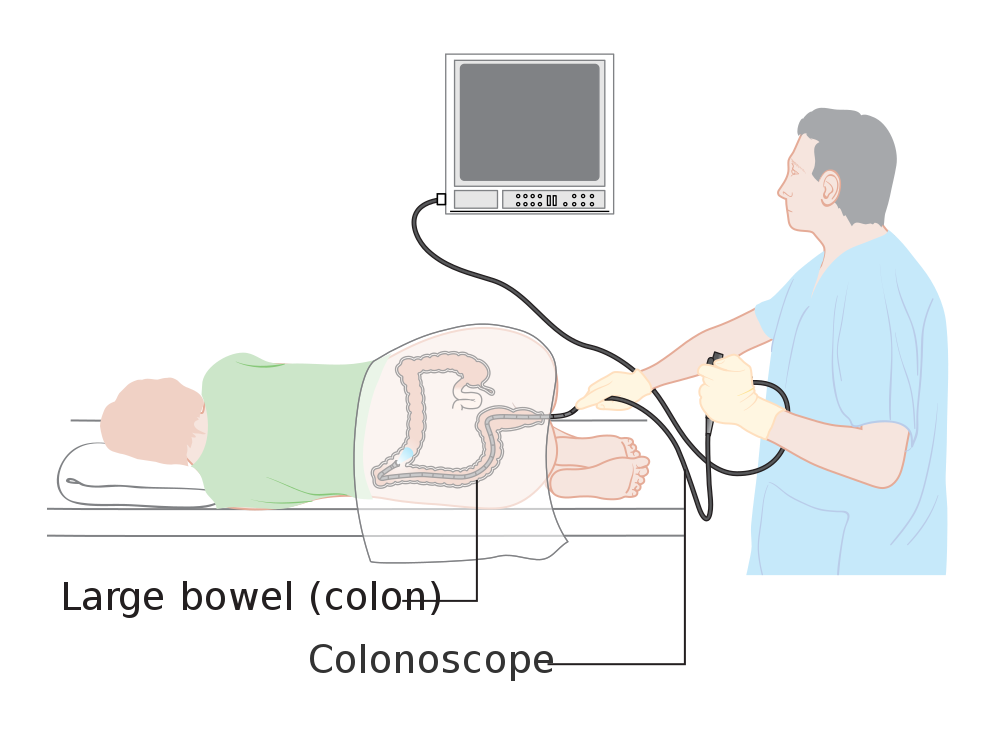
Barium Enema
A barium enema is a special X-ray of the large intestine including the colon and rectum. This test may also be referred to a “lower GI series.” It is an older diagnostic test that has been mostly replaced by the colonoscopy test. Prior to the procedure, the patient completes a bowel preparation regimen to cleanse the colon, which typically includes a clear liquid diet for 1-3 days, followed by the administration of laxative medication and/or an enema. During the procedure, an X-ray is taken, and then an enema containing barium is administered. Additional X-rays are taken as the patient changes position to get different views of the colon. See Figure 16.12[18] for an image of barium enema results. After the procedure, it is normal for the patient to have white stools for a few days. The patient should be encouraged to drink extra fluids, as appropriate, and a laxative may be prescribed to prevent hard stools that can cause constipation.[19]
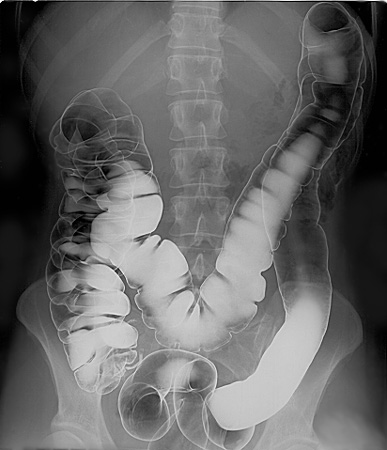
Abdominal CT Scan
An abdominal CT scan is an imaging method that uses a series of X-rays to create cross-sectional pictures of the abdomen. Because of the series of X-rays, patients are exposed to more radiation than when receiving a traditional X-ray. They will lie on a narrow table that slides into the CT scanner where the machine’s X-ray beam rotates around them. A computer creates separate images, called slices, that can be viewed on a monitor or printed on film. Three-dimensional models of the area can be made by stacking the slices together.[20] See Figure 16.13[21] for an image of a CT scan.
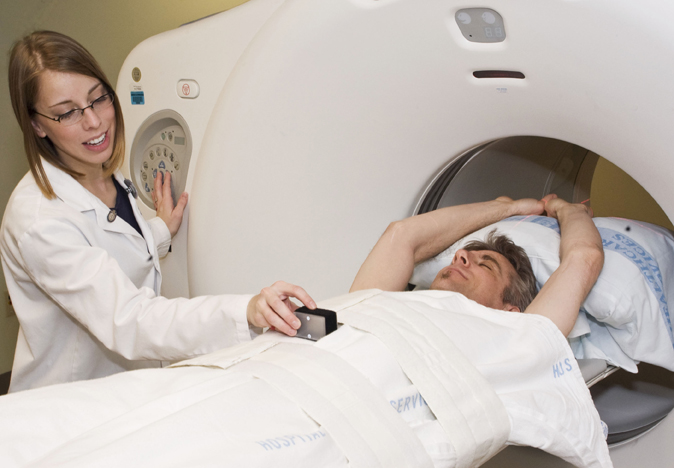
A special dye, called contrast, is administered to patients before some tests so that certain areas show up better on the X-rays. If contrast is used, the patient may be required to be NPO for 4 to 6 hours before the test. Contrast can be administered orally or intravenously.
Oral contrast has a chalky taste and will pass out of your body through the stools. Patients receiving IV contrast may feel a slight burning sensation, metallic taste in the mouth, or warm flushing of the body that resolves in a few seconds.
Before sending the patient for a procedure using contrast, check for previous allergies to iodine or other contrast dyes. Some patients may be prescribed diphenhydramine or corticosteroids before receiving the contrast if they have had a previous allergic reaction. Verify their kidney status because IV contrast can worsen kidney function. If the patient is currently taking the antidiabetic medication metformin, there may be restrictions placed on the administration of metformin before or after the procedure. Jewelry should be removed before the procedure.[22]
After the procedure, encourage patients who have received contrast to increase their fluid intake to help eliminate it from their body, as appropriate. If they received barium, their stools will be light in color. Post-procedural laxatives are typically prescribed to prevent the stool from hardening, which can cause an impaction or obstruction.
Diagnosis
There are several nursing diagnoses related to alterations in elimination. Refer to a nursing care planning resource for current NANDA-I nursing diagnoses and evidence-based interventions. See Table 16.9a for common NANDA-I diagnoses related to elimination.
Table 16.9a Common NANDA-I Nursing Diagnoses Related to Alterations in Elimination
| NANDA-I Diagnosis | Definition | Selected Defining Characteristics |
|---|---|---|
| Constipation | Decrease in normal frequency of defecation accompanied by difficult or incomplete passage of stool and/or passage of excessively hard, dry stool |
|
| Diarrhea | Passage of loose, unformed stools |
|
| Bowel Incontinence | Involuntary passage of stool |
|
| Stress Urinary Incontinence | Sudden leakage of urine with activities that increase intraabdominal pressure |
|
| Urge Urinary Incontinence | Involuntary passage of urine occurring soon after a strong sensation or urgency to void |
|
| Urinary Retention | Inability to empty bladder completely |
|
Sample PES Statements
Sample PES statements for the nursing diagnoses are as follows:
- Constipation related to insufficient fluid and fiber intake as evidenced by decreased stool frequency, hypoactive bowel sounds, and straining with defecation.
- Diarrhea associated with gastrointestinal irritation as evidenced by cramping, hyperactive bowel sounds, and greater than three liquid stools in 24 hours.
- Bowel Incontinence related to generalized decline in muscle tone as evidenced by a constant passage of soft stool.
- Stress Incontinence related to weak pelvic muscle floor muscles as evidenced by leakage of a small amount of urine when laughing and jumping.
- Urinary Urge Incontinence related to ineffective toileting habits as evidenced by the inability to reach the toilet in time to avoid urine loss and frequently wet underclothes.
- Urinary Retention associated with blockage in the urinary tract as evidenced by dribbling of urine in small amounts with frequent voiding and a reported sensation of bladder fullness.
Outcome Identification
See Table 16.9b for sample goals and outcome criteria associated with nursing diagnoses related to elimination alterations.
Table 16.9b Sample Goals and Outcome Criteria for Alterations in Elimination
| Nursing Diagnosis | Overall Goal | SMART Outcomes |
|---|---|---|
| Constipation | The patient will have a bowel movement every 1-3 days with soft, formed stool and ease of stool passage. | The patient will have a bowel movement with soft, formed stool in the next 24 hours. |
| Diarrhea | The patient will have a regular bowel elimination pattern with soft, formed stool. | The patient will report relief from cramping and fewer episodes of diarrhea in the next eight hours. |
| Stress Incontinence | The patient will have urinary continence as evidenced by no urine leakage with intra-abdominal pressure and dry underclothes and bedding. | The patient will report fewer episodes of stress incontinence in their bladder log over the next month. |
| Urge Incontinence | The patient will have urinary continence as evidenced by adequate time to reach the toilet and dry underclothes and bedding. | The patient will report fewer incontinence episodes over the next month. |
| Urinary Retention | The patient will experience improved urinary elimination as evidenced by complete emptying of the bladder and absence of urinary leakage. | The patient will report a feeling of complete emptying of the bladder by next week. |
Planning Interventions
Plan interventions customized to each patient’s alteration, cause of the condition, and related SMART outcomes. See interventions for each alteration under the corresponding sections earlier in this chapter.
Implementing Interventions
Assess a hospitalized patient’s bowel pattern and date of last bowel movement daily. Implement a bowel management plan as needed to achieve the goal of a bowel movement every one to three days to avoid constipation and impaction. Before administering laxatives and stool softeners, always assess the patient’s recent stool characteristics and withhold medication if loose stools or diarrhea are occurring. In the same manner, when administering medications for a patient with diarrhea, assess recent stool consistency and bowel pattern and withhold medication if the diarrhea is resolved or constipation is developing.
For many patients, alterations in elimination require patient education to teach the patient and their caregivers how to manage these conditions at home. Keep in mind that patient education is an independent nursing intervention, so a provider order is not necessary to provide this important information.
Evaluation
Evaluate the effectiveness of interventions based on the SMART outcomes established for each patient and their situation.
- “Bristol_stool_chart.svg” by Cabot Health, Bristol Stool Chart is licensed under CC BY-SA 3.0↵
- “Chemstrip2.jpg” by J3D3 is licensed under CC BY-SA 3.0↵
- MedlinePlus [Internet]. Bethesda (MD): National Library of Medicine (US); [updated 2020, Jun 9]. Urinalysis; [reviewed 2016, May 5; cited 2021, Feb 16]. https://medlineplus.gov/urinalysis.html↵
- “Pyuria2.JPG” by Bobjgalindo is licensed under CC BY-SA 4.0↵
- LabTestsOnline.org. (2020, March 21). Urinary tract infection.https://labtestsonline.org/conditions/urinary-tract-infection↵
- LabTestsOnline.org. (2020, August 12). Urine culture.https://labtestsonline.org/tests/urine-culture↵
- LabTestsOnline.org. (2020, August 12). Urine culture.https://labtestsonline.org/tests/urine-culture↵
- LabTestsOnline.org. (2020, August 12). Urine culture.https://labtestsonline.org/tests/urine-culture↵
- “Diagram_showing_a_cystoscopy_for_a_man_and_a_woman_CRUK_064.svg” by Cancer Research UK is licensed under CC BY-SA 4.0↵
- A.D.A.M. Medical Encyclopedia [Internet]. Atlanta (GA): A.D.A.M., Inc.; c1997-2021. Cystoscopy; [updated 2021, Feb 8; cited 2021, Feb 16]. https://medlineplus.gov/ency/article/003903.htm↵
- National Institute of Diabetes and Digestive and Kidney Diseases. (2014, February). Urodynamic testing. U.S. Department of Health and Human Services. https://www.niddk.nih.gov/health-information/diagnostic-tests/urodynamic-testing↵
- American Cancer Society. (2020, June 29). Colorectal cancer screening tests.https://www.cancer.org/content/cancer/en/cancer/colon-rectal-cancer/detection-diagnosis-staging/screening-tests-used.html↵
- “Guaiac_test.jpg” by unknown author is in the Public Domain↵
- American Cancer Society. (2020, June 29). Colorectal cancer screening tests. https://www.cancer.org/content/cancer/en/cancer/colon-rectal-cancer/detection-diagnosis-staging/screening-tests-used.html↵
- “Diagram_showing_a_colonoscopy_CRUK_060.svg” by Cancer Research UK is licensed under CC BY-SA 4.0↵
- MedlinePlus [Internet]. Bethesda (MD): National Library of Medicine (US); [updated 2020, Feb 3]. Colonoscopy; [reviewed 2018, May 1; cited 2021, Feb 16]. https://medlineplus.gov/colonoscopy.html↵
- American Cancer Society. (2019, January 14). Colonoscopy. https://www.cancer.org/treatment/understanding-your-diagnosis/tests/endoscopy/colonoscopy.html↵
- “Human_intestinal_tract,_as_imaged_via_double-contrast_barium_enema.jpg” by Glitzy queen00 at English Wikipedia is in the Public Domain↵
- A.D.A.M. Medical Encyclopedia [Internet]. Atlanta (GA): A.D.A.M., Inc.; c1997-2021. Barium enima; [updated 2021, Feb 8; cited 2021, Feb 16]. https://medlineplus.gov/ency/article/003817.htm↵
- A.D.A.M. Medical Encyclopedia [Internet]. Atlanta (GA): A.D.A.M., Inc.; c1997-2021. Abdominal CT scan; [updated 2021, Feb 8; cited 2021, Feb 16]. https://medlineplus.gov/ency/article/003789.htm↵
- ”UW_Medical_Center_PET-CT-Scan.jpg” by Clare McLean for UW Medicine is licensed under CC BY 3.0↵
- A.D.A.M. Medical Encyclopedia [Internet]. Atlanta (GA): A.D.A.M., Inc.; c1997-2021. Abdominal CT scan; [updated 2021, Feb 8; cited 2021, Feb 16]. https://medlineplus.gov/ency/article/003789.htm↵


